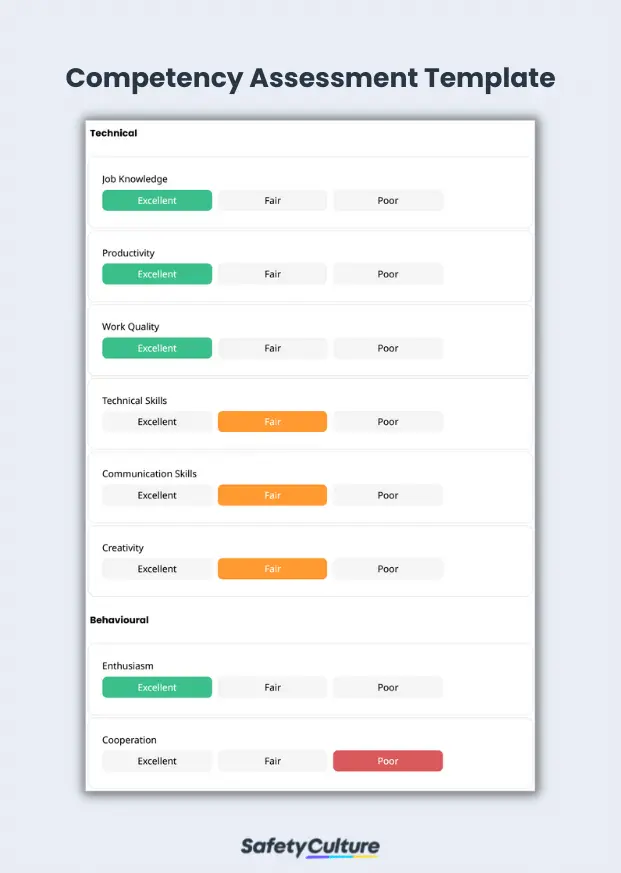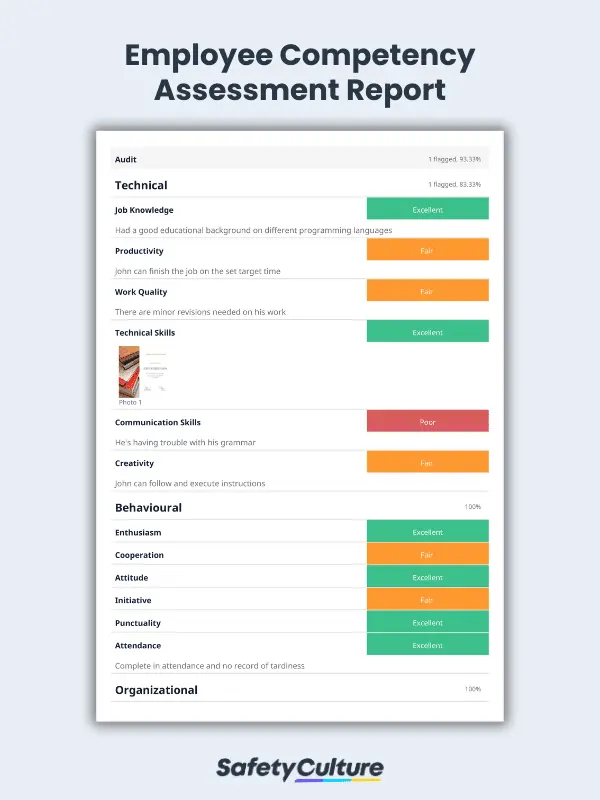What is a Competency Assessment Template?
A competency assessment template is a tool used to systematically measure skills gaps for specific roles across an organization. An effective competency assessment template should cover three key competency categories when assessing an employee’s capability: technical, behavioral, and organizational.
What is a Competency Assessment?
Competency assessment is the process used by organizations to identify an employee’s suitability for a given role. It is conducted either initially or periodically by a qualified individual assigned by the organization to measure an employee’s skills, knowledge, and performance against pre-defined benchmarks and job requirements. This test aims to determine gaps in skills and performance of an employee to determine the appropriate corrective actions such as providing training.
Employee competency assessments or tests are commonly confused with performance appraisals and employee evaluations. Competency tests determine if an employee fits a specific role, while performance evaluations measure the work performance of someone who has already been deemed suitable for the role.
Why Perform These Assessments?
Competency assessments are used to help identify gaps between an organization’s strategic plans and its existing employee competencies. They can assist with evaluating how employees use their knowledge and skills in on-job situations. Conducting competency tests can also help prioritize areas for further development and support focused on hiring decisions to fill those gaps.
To simplify this process, using a competency assessment template can be a game-changer. Here are the top reasons to utilize this template in your organization:
- Consistency – By outlining specific competency benchmarks and scoring systems, evaluators can carry out assessments consistently with no room for ambiguity or subjectivity.
- Efficiency – Templates provide a ready-to-use framework, reducing the time and effort needed to develop competency assessment tools.
- Focus and Direction – A well-designed template enables organizations to target specific skills and behaviors crucial for job success, making it easier for HR teams to find skill gaps and tailor training and development programs to address them.
- Scalability – These forms can be tailored for a wide range of competencies, which allows organizations to deploy competency evaluations across diverse teams and departments.
- Adaptability – Templates can be revised based on changing organizational needs, ensuring alignment with ever-evolving business goals and industry trends.
What to Include in a Competency Assessment Template
Competency assessment forms may have varying structures based on the job or task to be evaluated. But in general, they must cover the following components:
- Technical – job knowledge, productivity, work quality, technical skills, creativity, communication skills
- Behavioral – enthusiasm, cooperation, attitude, initiative, punctuality, attendance
- Organizational – work consistency, work relations, dependability
- Recommendations – key points for improvement
- Overall competency assessment rating – competent, needs work, not suitable
How Do You Write a Competency Assessment with a Template?
A well-crafted competency assessment template is a powerful tool for organizations aiming to excel in employee management and development. To ensure your organization delivers optimal results, follow these essential steps in creating your templates:
- Define the purpose and objectives of the competency assessment.
- Establish a competency framework outlining the core competencies required for the specific roles within your organization.
- Choose the appropriate assessment method based on the competency to be evaluated, such as self-assessment, peer evaluation, and supervisor reviews.
- Set specific benchmarks for each competency included in the assessment.
- When administering the competency assessment, give clear and comprehensive instructions to both employees and evaluators.
- Once the assessment is complete, analyze the results to identify patterns and determine strengths and weaknesses for individual employees and the overall workforce.
- Based on the competency test results, design personalized development plans to strengthen the identified competencies effectively.
- During the implementation process, regularly monitor the employee’s progress on their development plans.
- Run periodic reviews to evaluate the effectiveness of the assessment template and adjust as needed to get the best results.
Competency Assessment Sample
To better illustrate how things work, here’s a sample employee competency assessment report for your reference:
Role: Programmer
Overall Competency Rating: Competent (90-100% score)
Recommendations: Employee is fit for the job but needs to improve their communication skills
- Job Knowledge – Excellent: Employee has a bachelor’s degree in Computer Science
- Productivity – Fair: Employee can finish the job on the set target date
- Work Quality – Fair: There are minor revisions needed on the employee’s work
- Communication Skills – Poor: Employee has trouble using correct grammar
- Creativity – Fair: Employee can only follow and execute instructions
- Attendance – Excellent: No unnotified absences and no records of tardiness
- Work Relations – Excellent: Practices professionalism and integrity
- Dependability – Excellent: Employee supports teammates when the lead is unavailable
FAQs About Competency Assessment
The three common types of competency assessments for employees are self-assessments, manager assessments, and 360-degree assessments. Self-assessment is when the employee evaluates their own level of competence, while manager assessment is performed by the employee’s direct supervisor. 360-degree assessment, on the other hand, is an evaluation conducted by the employee’s managers, peers, and subordinates.
In addition to job performance, evaluations of an employee’s hard skills, product expertise, and soft skills can also contribute to a comprehensive competency assessment. Further, it is ideal to establish a predetermined set of criteria that can be the basis of whether an employee is competent enough for a given job.
Competency assessments can be performed by different individuals or groups, including HR professionals, managers and supervisors, colleagues and peers, subordinates, and even external consultants. The specific person or group responsible for the assessment will depend on the context, purpose, and established needs for that particular assessment.
Employee skills assessment targets an employee’s proficiency in a particular area or task, making it ideal for setting training and development benchmarks. On the other hand, competency assessment accounts for both technical and behavioral factors affecting an employee’s performance.




